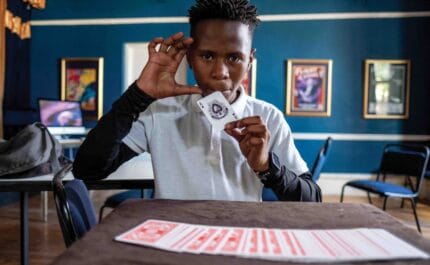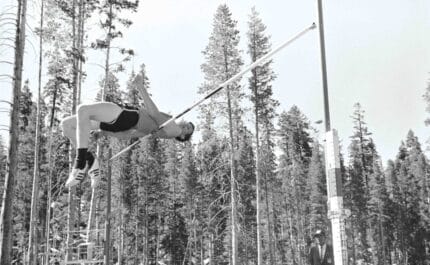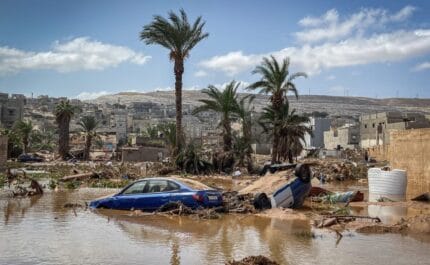Moment that mattered: Lahaina is destroyed by wildfires
In issue 52 we spoke to Maui resident Crystal Mitchell about her narrow escape from death

A person walks past destroyed buildings on Front Street, Lahaina, on 10th August 2023, two days after wildfires devastated the town. Photo: Patrick T. Fallon/AFP via Getty Images
8th August 2023 (Taken from: #52)
In August 2023 the Hawaiian island of Maui experienced the deadliest wildfires to hit the US for over a century. There were blazes across Maui, but by far the most destructive took hold on its western side, in the historic coastal town of Lahaina.
On the morning of 8th August, Crystal Mitchell and her husband Dallas stood in the garden of their Lahaina home and watched a fire burning on the other side of a field. It seemed too far away to pose a threat, and the blaze, caused by power lines falling in strong winds, was being monitored by firefighters, who later declared it contained and left the scene. Mitchell remembers thinking to herself while watching the distant blaze, “Well, whose home burns down twice?”
In 2018, Mitchell’s three-bedroom family home had been one of 21 structures on Maui to be destroyed by wildfires propelled by tropical storm-force winds. They rebuilt it on the same spot, but five years later the wildfires were far worse, threatening not just their home and a few others, but the entire town of Lahaina.
“By the afternoon of 8th August the winds were really strong,” Mitchell recalls. “We saw the fire flare up a quarter of a mile from our house. There’s nothing between there and our home – a field and a road, but no structures.” When the fire started sweeping through the dried grass in the field at speed, Mitchell realised they were in trouble. “I went inside to start packing up our stuff and in a matter of minutes my husband screamed ‘Get in the truck!’ But it was too late – our home had caught fire while we were still inside,” she says.
The Mitchells’ two boys, aged nine and ten, escaped the house safely. But Dallas suffered burns to his face, nose and ears, and broke his ankle when the winds blew him off the six-foot wall behind their house as he tried to get away. Their dogs, Nellie and Buttercup, died in the blaze, says Mitchell tearfully. It all happened so quickly. “By the time we were in our vehicle the fire had wrapped itself around our truck and the back of my neck and my hair got singed,” she says. “Then we drove through the fire away from our home. The traffic was bumper-to-bumper and it was pitch black, just black smoke everywhere. My husband drove the wrong way down the road and it was a miracle we didn’t run anyone over. It felt like the fire was chasing us.”
Thousands of structures in Lahaina, a town of 13,000 people and hotspot for the three million tourists who visit Maui each year, would be razed to the ground by the blaze. Mitchell says that her house was the first to go. The speed of the fire, which travelled at around a mile a minute, was terrifying and nearly 100 people in the town lost their lives. The family drove through the smoke to Front Street, Lahaina’s vibrant heart, known for its art galleries, boutique shops and quaint eateries – as well as a beloved banyan tree, the largest in the US – while dodging collapsing power lines and people running out of buildings in a panic. Some jumped into the ocean to escape the flames and were later rescued by the Coast Guard. Eventually the Mitchells reached a friend’s house in Kahana, eight miles north of Lahaina, where they stayed for a week.
Mitchell says that her family left their home with nothing. They didn’t even have shoes on their feet. “The first time our house burned down, in 2018, we had warnings,” she says. “I had stuff packed up, we were prepared to leave. On 8th August we had no alerts on our phones, nothing at all.” The authorities were absent from the scene. “The fire trucks put out the morning fire and then left, and when it restarted there was nobody.”
After the blaze, central Lahaina was fenced off by a large black dust screen and patrolled by National Guard troops while crews removed hazardous materials. One by one, neighbourhoods reopened for residents to return and see what was left of their homes. Mitchell and her family had to wait until November. “There was nothing,” she says. They were met by members of a Christian disaster relief charity, Samaritan’s Purse, who helped them in the futile act of sifting through the rubble to search for possessions. “It was amazing to see people there to help us. The possessions mean nothing to me. Losing my dogs and seeing my husband hurt, that’s what’s painful,” she says.
The difficulties Mitchell experienced trying to get urgent medical care for her husband seem symbolic of the Hawaiian authorities’ lack of preparedness. He was experiencing excruciating pain but couldn’t get to a doctor for five days due to road closures, and the local fire department didn’t have any cream to treat burns. They eventually reached a doctor on the other side of the island but a road was closed while they were there and they were separated from their distressed children for a night. “Nobody [in authority] seemed to know what was going on,” Mitchell says, explaining that they later travelled to the mainland US so her husband could get surgery on his broken ankle.
Three months after the blaze the Mitchells are spending much of their time trying to keep their water sports business, 808 Boards, alive. Their store survived, but they lost most of their rental surfboards and paddleboards in the fire. “We’ve also lost about 80 percent of our revenue,” Mitchell says. “We were closed for a little over a month and although we’re open full-time now we haven’t been able to bring back our employees. Like most people in West Maui our business depends on tourism, but there aren’t many tourists.” Their local business has also dried up because almost no-one from Lahaina has any work, she says, adding that they’re working with a local charity, Mana Mentors, to run pop-up skate events for kids in displaced families who lost their skate park in the fire. No financial assistance has been offered by the government aside from small business loans.
It was pitch black, just black smoke everywhere… It felt like the fire was chasing us”
Despite having lost two houses to wildfires, the Mitchells are determined to stay in Maui. They’re working through the insurance claims and hope to rebuild for a second time, even though there’s an awful lot of work to be done before that can happen. The entire town is covered in debris, and its residents are still waiting for the authorities to announce a timeline for its removal.
Both Mitchell and her husband are originally from the US mainland. Weren’t they tempted to return, especially since climate change – a contributing factor to the hurricane-strength winds – seems to be making extreme weather events on Maui more frequent and destructive? “The thought did come up right at the start,” she replies. “But I’ve been in Maui for 16 years and my husband for nearly 20. Our sons were born and raised here. When we went to the mainland for my husband’s surgery my youngest son cried every day. He wanted to go home… You know, we’ve been through this twice now and I really believe that we’re here for a reason, to help people. We’re part of the community, we have to rebuild. We’re here to stay.”
Lahaina will be rebuilt one day, but it will never be the same. As well as the tragic loss of human life, its historical gems have gone – the 19th-century courthouse, the church established by Queen Keopuolani 200 years ago and all three Japanese Buddhist wooden temples. The former capital of the Hawaiian Kingdom, the home to kings and queens for centuries and previously West Maui’s biggest tourist draw, has been incinerated. Signs of hope have been few and far between, but in September the iconic 150-year-old banyan tree on Front Street, badly charred by the fire, sprouted new leaves. The tree has long represented the town’s spirit and resilience – and Mitchell says that it’s been amazing watching the community rally round to help and comfort each other in the months since the fire.
Despite everything, Mitchell says, her family are alright. They’re among the few displaced residents to have secured a long-term rental property and her boys are “doing amazing”. Yet everyone is demanding answers. Why couldn’t the power lines withstand strong winds? While Hawaii Electric Co accepts that its downed lines caused the initial fire, it says that it isn’t responsible for the flare-up later in the day. Why did the firefighters go for lunch after claiming that the blaze was 100 percent contained? Maui County fire officials deny claims of negligence. Why hadn’t the vegetation, the dry and abundant grasses that stood between the Mitchell home and the site of the flare-up, been managed by anyone? Why did the authorities underestimate the speed and lethality of the fires? And after the fire had reached Lahaina, why did Hawaii’s extreme-weather siren warning system, the largest in the world according to state officials, remain silent?
“The fires we lost our home to five years ago should have been a clear warning,” says Mitchell. “I don’t want to say that the authorities didn’t care, but they certainly didn’t make a plan, they didn’t think it would happen again.” Her husband, she says, now has nine screws and a plate in his heel and everyday activities are challenging for him. “If there had just been a warning we would have been prepared. Why wasn’t there a warning?
Slow Journalism in your inbox, plus infographics, offers and more: sign up for the free DG newsletter. Sign me up
Thanks for signing up.








